5 Essential Types of Employee Recognition—and How to Use Them

Updated on
March 19, 2024
In a recent global survey, only 21% of companies worldwide had fully integrated employee recognition into their organization. The other 80% are missing out on the benefits—decreased burnout, increased retention, and a workplace culture encouraging people to deliver their best work.
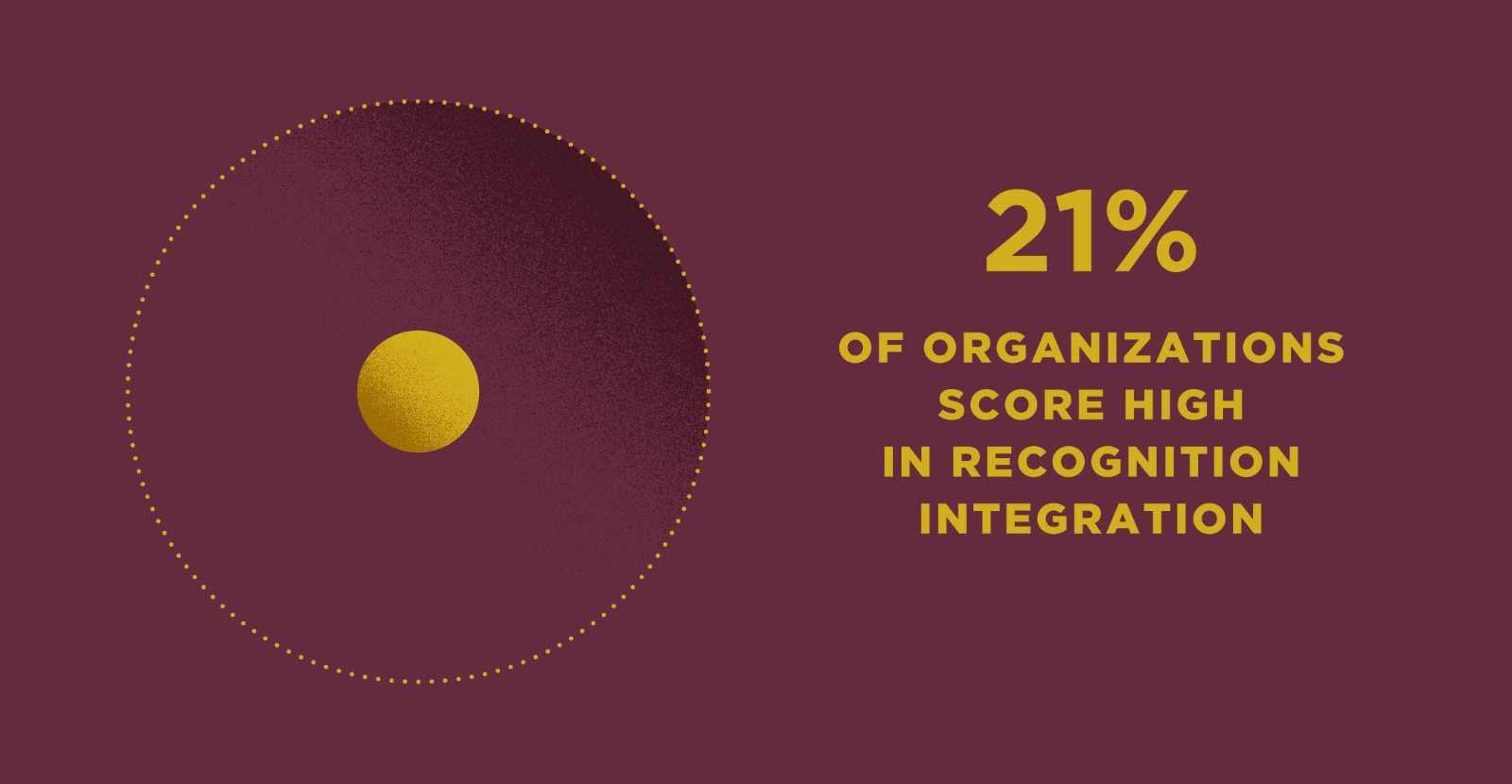
What can we do to increase that number? This has been our mission at O.C. Tanner for the nearly 100 years we’ve spent in the employee recognition business. In that time, we’ve learned there are five essential types of employee recognition organizations should practice to make employee recognition effective.
Understanding and practicing these five essential types of employee recognition will elevate your employee experience and company culture so top talent will join and stay at your organization.
Let’s dive into them now.
Peer-to-peer employee recognition
The first essential type of employee recognition is peer-to-peer recognition, where employees acknowledge and appreciate the efforts and achievements of their teammates across the organization.
Recognition shouldn’t only come from managers or supervisors. Peer-to-peer recognition gives employees the opportunity to play a significant role in recognizing and celebrating the contributions of their peers.
Why peer-to-peer recognition is important
Peer-to-peer recognition helps build a strong workplace community where people feel seen, valued, and appreciated.
When employees are empowered to recognize their coworkers for accomplishments big and small, it allows peers to connect across the organization. Plus, team members often notice the day-to-day efforts of their coworkers that managers might not have the opportunity to see.
Our research shows there is a 26% increase in engagement scores when employees give recognition to each other.
And, when recognition happens regularly in teams, the odds of having a strong community at work increase exponentially.
How to encourage peer-to-peer recognition
To encourage peer-to-peer employee recognition in your organization, start by ensuring every employee has the opportunity to give recognition, regardless of job title, tenure, or function. Make sure everyone has access to your company’s recognition tools and platforms and knows how to use them.
Next, facilitate frequent recognition moments with your team. Start a team meeting by asking if anyone has appreciation to share and remind employees to share thanks at least once a month. If they’re not comfortable expressing their thanks in front of others, they can always send a note or an eCard.
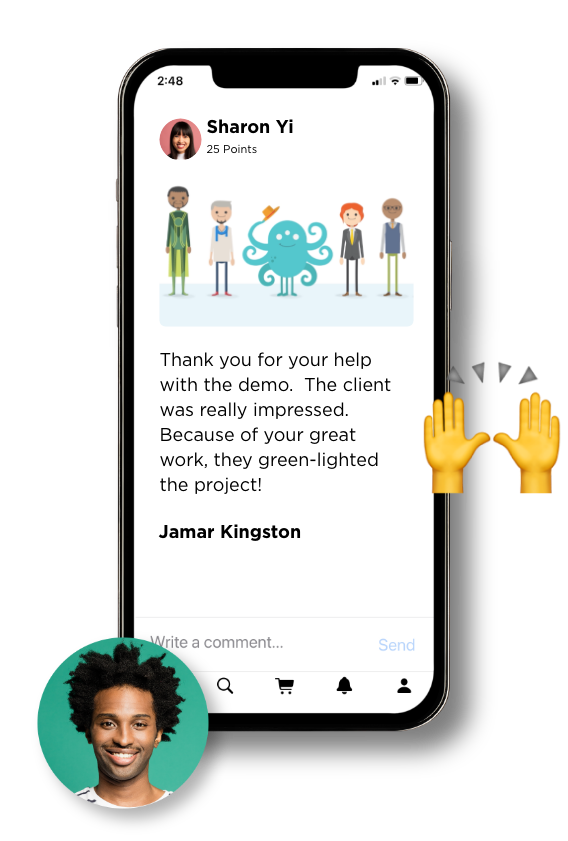
Publicize recognition across the organization so everyone can see the great work happening. You can highlight recent recognition on the company intranet, around break areas, or on digital monitors placed throughout your workspace.
Employee recognition software, like Culture Cloud, includes a social wall that features new recognition moments and encourages employees to like and comment on great work.
By showing employees that their peer-to-peer appreciation is important, it encourages them to share recognition more consistently with colleagues.
Leader-to-employee recognition
The second essential type of recognition is leader-to-employee recognition. Unlike peer-to-peer recognition, where employees recognize each other, leader-to-employee recognition involves supervisors, managers, and other leaders expressing gratitude and appreciation to their immediate team.
This form of recognition is crucial for fostering a positive workplace culture and motivating employees to excel in their roles.
The benefits of leader to employee recognition
Leader-to-employee recognition is a fundamental aspect of employee engagement and retention. In fact, when leaders recognize their employees regularly, there is an 83% increase in employee engagement.
The other benefits of leader-to-employee recognition are just as impactful:
- Employees are 18x more likely to produce great work if they are recognized
- 90% of employees have high trust in a leader who recognizes their accomplishments
- Employees are 44% less likely to burnout when recognized by leaders
How leaders can share meaningful recognition
Recognition is most meaningful when it is timely, specific, and personalized to the individual receiving it. When we say timely and specific, we mean the appreciation is shared close to the event (for example, a completed project) and includes details showcasing the impact the work and the employee have on the organization as a whole.
70% of employees of employees say recognition is most meaningful to them when it’s personalized.
Leaders should ask questions of their employees to figure out their recognition preferences. For example, does the employee prefer private or public recognition moments? What is their favorite treat or gift? By personalizing recognition moments you show your employees that you truly value their contributions and that you know them on an individual level.
There are many benefits to investing time in discovering employee recognition preferences, such as higher employee engagement and employee Net Promoter Score:
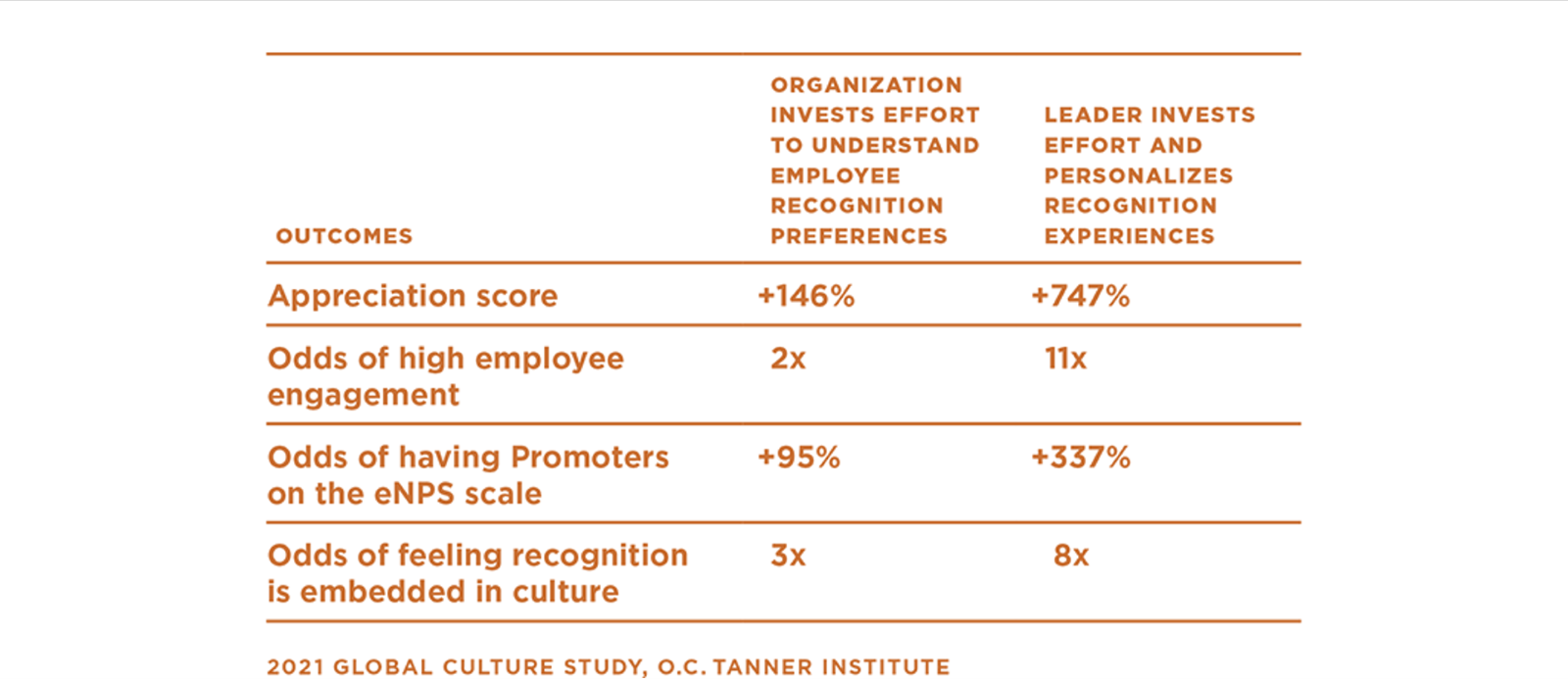
To see all of the occasions that leaders can recognize and celebrate employees, check out our guide to giving purposeful recognition.
Employee-to-leader recognition
Recognition should flow both ways between leaders and employees. This brings us to the third essential type of recognition: employee-to-leader. This is when teammates recognize and appreciate their immediate leaders for their help and great work.
While it’s customary for leaders to recognize their direct reports, those same leaders also benefit from receiving recognition from their teams.
Why leaders need appreciation too
According to new research from our Global Culture Report, leaders are burning out more than ever before—even more than their employees. The widening gap in burnout can be attributed significantly to the lack of recognition that leaders receive compared to employees.
Leaders need to feel appreciated, especially by their immediate team. In our research, 65% of leaders admit that receiving more recognition from the people who report to them would improve their experience at work.
When leaders have a strong connection to their teams, their sense of wellbeing, as well as their perceptions of the culture improve substantially:
- Anxiety (–67%)
- Stress (–35%)
- Engagement (+718%)
- Purpose (+562%)
- Opportunity (+637%)
- Success (+748%)
- Appreciation (+631%)
- Wellbeing (+243%)
- Thriving Culture (+1,691%)
Leaders deserve to feel valued, appreciated, and supported like everyone else.
How employees can recognize their leaders
Employees can elevate their leaders by formally recognizing their work through award nominations that are shared throughout the organization—on a company intranet, an employee recognition program, or in-office monitors.
But it doesn’t have to be complicated. The same type of recognition that occurs between peers can be shared from employees to leaders. “Thank you” notes and small tokens of gratitude can go a long way for leaders that may feel under-appreciated and overlooked.
Work anniversary recognition
Another essential type of employee recognition is one that happens every year—recognition on work anniversaries. This recognition moment occurs on or around an employee’s hire date at an organization.
While it is important to celebrate the major career milestones—1 year, 5 years, and so on—taking a moment to recognize the “in-between” years is just as necessary.
One of the greatest benefits of work anniversary recognition is the positive impact on employee retention. Employees stay at organizations for 2–4 more years when their company celebrates career milestones.
How to celebrate career milestones
Work anniversary recognition moments should feel different than day-to-day recognition. Schedule some time, maybe 30 minutes to an hour, for teammates and leaders to gather and share remarks about the celebrant. This is a great time for sharing stories, memories, and jokes while creating a sense of connection between teams.
Employees stay at organizations for 2–4 more years when their company celebrates career milestones.
Additional components of celebrating work anniversaries are gifts and awards. If you have a work anniversary recognition program, you can encourage the celebrant to pick out awards and gifts from your award catalog.

If you don’t have a work anniversary program, consider Culture Cloud Anniversaries to help you automate and enhance your employees’ career milestone celebrations with awards and a personalized yearbook filled with peer comments and memories.
Check out our tips for celebrating major career milestones.
Company-wide recognition
The final type of essential recognition is company-wide recognition. It’s always great to gather teams from across the organization to celebrate major accomplishments everyone achieved together. Whether it be reaching company goals, launching a new product line, or celebrating a company anniversary, there are so many opportunities to hold company-wide recognition moments.
This is a great way to foster connection and belonging at work. According to our research, employees with strong connections are 11 times more likely to stay at their organization for another three years, and both employees and their organization are more likely to thrive.
There are even more benefits to celebrating together and feeling connected as a company:

Include offline and remote employees in company-wide recognition moments
Company-wide recognition moments are only impactful if they actually include everyone.
If you have a large offline or “deskless” population, make sure they are given time to attend recognition moments and celebrations during their workday. And provide ample space for everyone to gather.
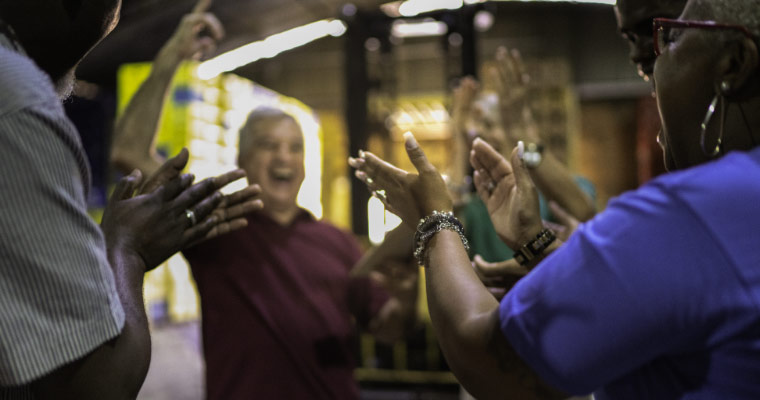
For remote workers, ensure your celebration includes a digital element. Include them on a live call so they can receive information in real time, and share comments and excitement in a chat or over audio. Make sure your presenters stick close to the microphone too so your virtual attendees don’t miss anything.
Bringing it together: The integrated employee recognition model
While practicing any type of employee recognition will create improved cultural results, practicing them together will create a massive, positive shift in your employee experience. We call this the integrated recognition model.
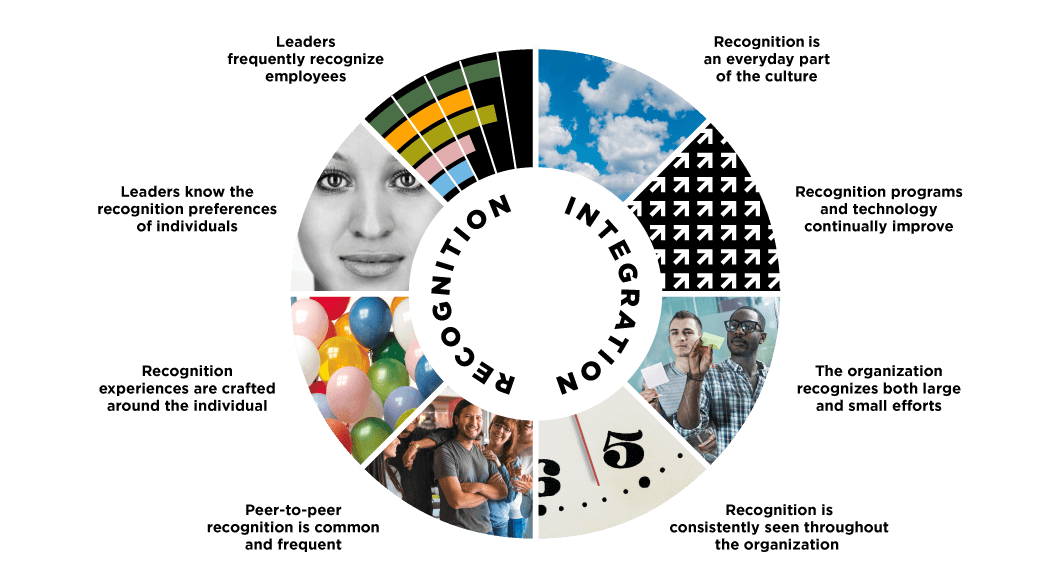
Employee recognition becomes fully integrated to your organization when:
- Employee recognition is an everyday part of company culture
- Recognition programs and technology continually improve
- The organization recognizes both large and small efforts
- Recognition is consistently seen throughout the organization
- Peer-to-peer recognition is common and frequent
- Recognition experiences are crafted around the individual
- Leaders know the recognition preferences of individuals
- Leaders frequently recognize employees
Highly integrated recognition has a powerful impact on organizations, increasing the odds of several positive outcomes and decreasing the odds of some negative ones:
- Great work (+1,181%)
- High engagement (+784%)
- Thriving culture (+648%)
- Employee attrition (–29%)
- Employee burnout (–80%)
When your company is intentional about the types of recognition you want to encourage—in other words, when you establish a clear employee recognition strategy—it will increase your odds of seeing the major cultural improvements that come with employee recognition.
From onboarding to the daily employee experience, employee recognition should be part of it all. Dive in to the strategies your organization can use to move from low to high recognition integration from our Global Culture Report.


.png)
